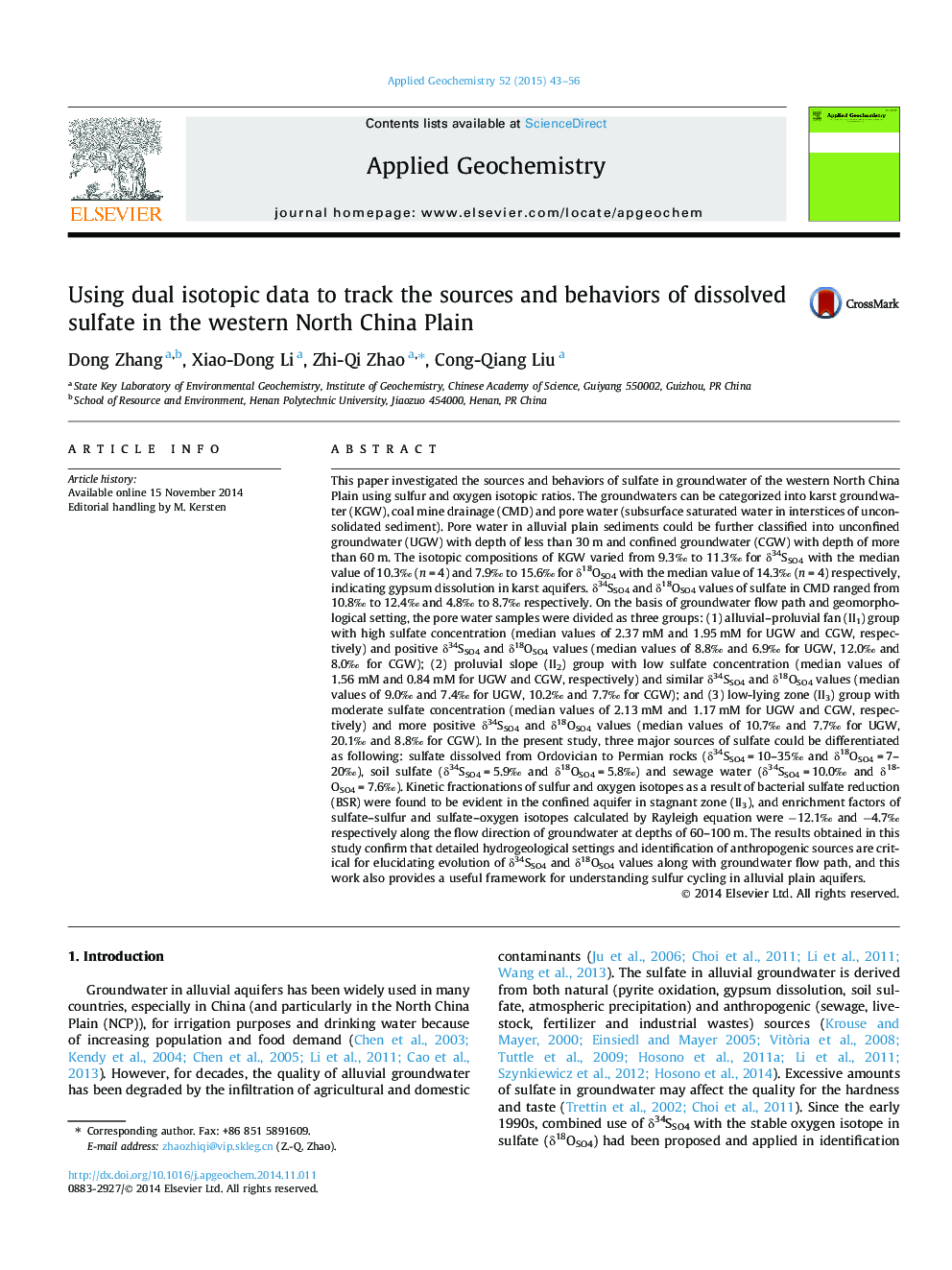| کد مقاله | کد نشریه | سال انتشار | مقاله انگلیسی | نسخه تمام متن |
|---|---|---|---|---|
| 4435714 | 1620239 | 2015 | 14 صفحه PDF | دانلود رایگان |
• Dual sulfate isotopes were used to elucidate natural and anthropogenic sources in alluvial aquifers.
• Infiltration, mixing and bacterial reduction were main processes controlling sulfate behaviors in groundwater.
• Enrichment factors and ratio of sulfur and oxygen isotope of sulfate had been calculated.
• Local sulfur cycles model had been establish for further management of groundwater.
This paper investigated the sources and behaviors of sulfate in groundwater of the western North China Plain using sulfur and oxygen isotopic ratios. The groundwaters can be categorized into karst groundwater (KGW), coal mine drainage (CMD) and pore water (subsurface saturated water in interstices of unconsolidated sediment). Pore water in alluvial plain sediments could be further classified into unconfined groundwater (UGW) with depth of less than 30 m and confined groundwater (CGW) with depth of more than 60 m. The isotopic compositions of KGW varied from 9.3‰ to 11.3‰ for δ34SSO4 with the median value of 10.3‰ (n = 4) and 7.9‰ to 15.6‰ for δ18OSO4 with the median value of 14.3‰ (n = 4) respectively, indicating gypsum dissolution in karst aquifers. δ34SSO4 and δ18OSO4 values of sulfate in CMD ranged from 10.8‰ to 12.4‰ and 4.8‰ to 8.7‰ respectively. On the basis of groundwater flow path and geomorphological setting, the pore water samples were divided as three groups: (1) alluvial–proluvial fan (II1) group with high sulfate concentration (median values of 2.37 mM and 1.95 mM for UGW and CGW, respectively) and positive δ34SSO4 and δ18OSO4 values (median values of 8.8‰ and 6.9‰ for UGW, 12.0‰ and 8.0‰ for CGW); (2) proluvial slope (II2) group with low sulfate concentration (median values of 1.56 mM and 0.84 mM for UGW and CGW, respectively) and similar δ34SSO4 and δ18OSO4 values (median values of 9.0‰ and 7.4‰ for UGW, 10.2‰ and 7.7‰ for CGW); and (3) low-lying zone (II3) group with moderate sulfate concentration (median values of 2.13 mM and 1.17 mM for UGW and CGW, respectively) and more positive δ34SSO4 and δ18OSO4 values (median values of 10.7‰ and 7.7‰ for UGW, 20.1‰ and 8.8‰ for CGW). In the present study, three major sources of sulfate could be differentiated as following: sulfate dissolved from Ordovician to Permian rocks (δ34SSO4 = 10–35‰ and δ18OSO4 = 7–20‰), soil sulfate (δ34SSO4 = 5.9‰ and δ18OSO4 = 5.8‰) and sewage water (δ34SSO4 = 10.0‰ and δ18OSO4 = 7.6‰). Kinetic fractionations of sulfur and oxygen isotopes as a result of bacterial sulfate reduction (BSR) were found to be evident in the confined aquifer in stagnant zone (II3), and enrichment factors of sulfate–sulfur and sulfate–oxygen isotopes calculated by Rayleigh equation were −12.1‰ and −4.7‰ respectively along the flow direction of groundwater at depths of 60–100 m. The results obtained in this study confirm that detailed hydrogeological settings and identification of anthropogenic sources are critical for elucidating evolution of δ34SSO4 and δ18OSO4 values along with groundwater flow path, and this work also provides a useful framework for understanding sulfur cycling in alluvial plain aquifers.
Journal: Applied Geochemistry - Volume 52, January 2015, Pages 43–56
